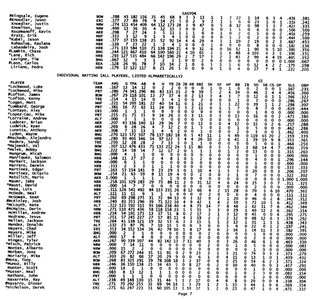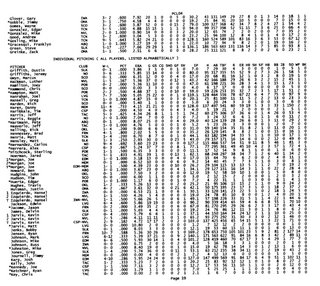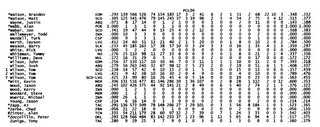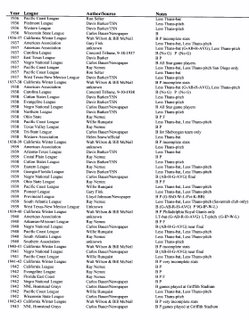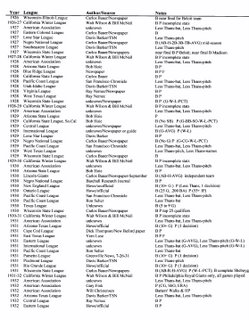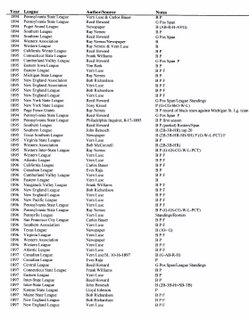Friday, March 31, 2006
Thursday, March 30, 2006
Wednesday, March 29, 2006
Tuesday, March 28, 2006
Monday, March 27, 2006
Sunday, March 26, 2006
Brian Mohr As In....
I posted the following on SABR-L, basically to inform people that I’d be posting PCL & Eastern League batting and pitching league stats, expecting nothing in the way of crimes against nature…
2004 Minor League Stats Redux
When I brought up the problem of the 2004 minor league statistics, critics maintained that the 2005 Sporting News Guide published what they had been sent, and that—in any case—they no longer existed in any form.
Since then I have been able to come up with a set of official minor league stats, and they do contain considerable data not contained in the TSN Guide. For example, TSN guide misses about a third of either the batting or pitching stats for the PCL. More than half of the Fresno pitching staff is missing from the guide, but appears in the official stats. Another league missing considerable data is the Eastern League, though no quite as bad as the PCL.
As a public service, I have decided to begin an eight-day posting of the batting and pitching average for those two leagues in facsimile of the official sheets, and you can judge for yourself what are the facts of the matter.
Carlos Bauer
No more (catchy, no) than posting the above, the critics came out of the woodwork… I leave in all the gory details, spelling mistakes and bad grammar, so please be warned…
Carlos
What are you contending is a correct stat for the minor leagues. I also had seen the FSL stats were incorrect in the 2005 book. I also noted that in 2005 the stats will be incorrect as well due to inaccurate box scores. To my knowledge these were never corrected and this was found just by me going to a game and know what had occurred (ie a pitching change in an inning and no record of the new pitcher ever appearsing and a batter getting an extra plate appearance when the 5 batters in front all had 1 less appearance). I have to wonder how accurate minor league info is when many of the leagues use interns and do not have many checks and balances to make them correct.
Brian Mohr
--Advanced Mortgage Professionals 239-542-4413 Fax 239-542-4486
Anyway, Mr. Mohr (As in…) meet Mr. Bauer:
Brian:Do you have a reading problem? I never maintained the official statistics for 2004 are correct— just that they are complete. Inaccuracies have occurred since the first box score was conceived. What TSN did is compound the 2004 problem by missing a third of the lines for the Coast League, a great number of lines in the Eastern League, etc.I will explain it to you one last time: The Sporting News received the official stats from The Sports Network-- and failed to put all the batting and pitching lines they received in their guide. If you still are confused, reread what I wrote below until you do understand.cb
What was the purpose of what Brian Mohr (As in…) wrote? Do we publish baseball encyclopedias that years later we find had a “phantom player” or find a player not included in one of many box scores?
Why do these people still attack me for trying to make the record more complete? Is it that SABR has become a fanatical church— where nobody dare speak the truth?
I suppose no good deed goes unpunished....
The Stats That Don't Exist, 2004 Redux
I was told that the official stats for the minor leagues for 2004 no longer exist, and for that reason the Sporting News would be unable to post the complete stats on their website for all those who bought the 2005 Sporting News Guide that was missing considerable data.
I was able to find somebody who made a copy of all the 2004 O. B. Stats, and offered to make a copy available to me. I want to thank that person from the bottom of my heart.
I called Willie Runquist yesterday. Runquist— as has been documented here— is the researcher who blew the whistle on 2004 TSN Guide. He told me that the worst two leagues in the guide were the Pacific Coast League and Eastern League. For instance, half the Fresno pitching staff was missing. And he calculated that fully a third of league players were missing a batting or pitching line.
One researcher who took exception to my criticisms of TSN, stated flatly that the stats TSN published were the same ones that they got from the provider, Sports Network, Inc.
As you will see, that is not the case. Beginning tomorrow, I will begin an eight-day posting of the batting and pitching average for those two leagues in facsimile of the official sheets, and you can judge for yourself.
Saturday, March 25, 2006
Some Updates/Corrections from Gary Fink
Eli Cates has been on my "One Year Wonders" list for players who only played one year in the Major Leagues but played a lot that year.
Recently I went on Ancestory.com to see where he was living during the census years. I found out he had a twin brother named Levi.
It has bothered me for a long time that there is no win-loss record for him in 1903 in the Missouri Valley League. He has a lifetime record in the minors of 156 wins and 163 losses. So I started gathering information on the league. I got copies of the SL, Reach, and Spalding Guides and compiled the information. In doing so, I noticed that the SABR Guide to Minor League Stats states that there is "R" listed in the Spalding Guide and TSN. While I do not have TSN (I have ordered it) the Spalding Guide does not have "Runs" for the batters. Delete "R" from the Spalding Guide from The New SABR Guide to Minor League Statistics.
Going through The Historical Register I noticed that "Big Ed" Reulbach (one of your Cubs) is listed with playing in the Missouri Valley League in 1901, 1902, & 1903. I know Ed Reulbach, born in Detroit, Michigan, helped beat the Detroit Tigers in the 1907 & 1908 World Series. He is not listed in the final batting stats in Sporting Life, Reach, and Spalding Guides. I checked the 1940 Baseball Register and it lists that he played under the name of Lawson while in the Missouri Valley League. There is a Lawson listed with playing with Sedalia in 1903. It needs to be added to The Historical Register for Reulbach.
Gary
Friday, March 24, 2006
Al Federoff

Some time ago Robert Morphy asked me to put together a career record for Al Federoff. I only do that when I get inspired, and I did because Al Federoff was they player I admired when I was a young kid in San Diego playing second base.
When the club traded Federoff to Seattle, the whole town was up-in-arms, as I remember it. (Well, at least, I was.) But if you look ove his record, you'll see that he was nearly at the end of his baseball career, and that Padres GM Ralph Kiner had it exactly right.
Thursday, March 23, 2006
James Francis Thorpe
Dick Beverage and I were talking the about Tommy Sheehan yesterday, and he felt that there might be a possibility of Sheehan’s height being a typo, that “8” might actually have been a “3” at some point. This has happened to me— and every body else— who has worked with old microfilm, and old guide pages, especially photocopies of guides.
Anyway, there is no way for us to that out, but we did agree that somebody called “Midget” would be closer to 5’3” than 5’8” in stature, and that the encyclopedias should— for the time being— eliminate the 5’8” from future editions. I told Dick that I had passed “the Midget” information on, but nothing had come of it. (It only occurred to me later that people who compile encyclopedias wouldn’t especially like to admit they don’t know something.) Dick told me that he had the same thing occur to him in regard to Jim Thorpe. He stumbled across an article that stated that Jim Thorpe had died in his trailer. Dick, of course, knew the trailer park where Thorpe had his trailer, and the park was located in Lomita, not Long Beach, as the encyclopedias still maintain. He passed that bit of information on to no avail.
Then after I got off the phone and began to correct my database, I noticed that the correction I had made to the Thorpe record that is still not carried by the encyclopedias. After Thorpe got back from the 1912 Olympics, he so dominated those games that he was sent to be examined by a group of scientist to see if they could find anything in his physique that might account for his dominance at the games. They didn’t, but the scientists did measure every inch of Jim Thorpe’s body. What is of interest to baseball researchers, historians and fans is the fact that Jim Thorpe measured 5’11” tall. When this bit of data was passed on, it, too, fell on deaf ears. The encyclopedias still list the “Greatest Athlete of All Time” at six feet one inch tall.
I believe what Ken Burns once said about Enos Slaughter spiking of Jackie Robinson incident. When somebody brought to Burns’ attention that Slaughter maintained that the incident never occurred, Burns— not the sharpest knife in the drawer— said: “But I’ve read it in 23 places!” What tends to happens is that one writer (researcher, etc.) puts something down on paper, and then others put that fact down on paper. So in Burn’s example, one guy may have made the whole thing up out of whole cloth, and 22 guys copy what the first guy wrote.
And that, I believe, is why is so hard to correct anything in baseball encyclopedias.
Wednesday, March 22, 2006
Some Questions from Rex Hamann
Rex asked me to post these questions that he has had, and will do so here .
On to a baseball question for you. I'm writing about Stoney McGlynn (again)in my Spring issue of the Almanac and am looking at his record 14 shutouts in one season. Do you know of anyone who has come close to this in the minors or if the record has ever been exceeded?
I found two Coast Leaguers with 14: Jimmy Whalen in 1905, and Vean Gregg in 1910, and searched my 19th century database, but didn’t find anything that beat it. However, the data is very sketchy in regards to shutout, complete games, etc.
And what about short games? For example, recalling that McGlynn did this in 1909, would a 6-inning run-less game be considered a shutout? A 5-inning? Which leads to my final question: would a 5-inning game be considered as an official "complete game" for either winner or loser? Not sure why it wouldn't but just never thought about it before.
I believe shutouts were handled like 7 inning no-hitters, etc. If anybody had any knowledge of this, please let me know, and I’ll post it here
By the way, A new issue of the Almanac with be out in about three weeks.
Rex
If you can help Rex, please contact him.
Rex Hamann
14201 Crosstown Blvd. NW
Andover, Minnesota 55304
The American Association Almanac,
A Baseball History Journal (1902-1952)
www.AmericanAssociationAlmanac.com
Subscriptions available...Be the first on your block!
Tuesday, March 21, 2006
Thomas H Sheehan
Born: November 6, 1877 Sacramento, CA
Died: May 22, 1959 Panama City, Panamá
BAT: R THROW: R HEIGHT: 5'8" WEIGHT: 160
Tommy Sheehan— 3b
1898 Sacramento (PCL)
1899 Sacramento (Cal)
1900 Sacramento (Cal)
1901 Sacramento (Cal)
1902 Sacramento (Cal)
1903 Sacramento (PCL)
1904 Tacoma (PCL)
1905 Tacoma (PCL)
1909 Oakland (Cal St)
1910 Stockton (Cal St)
1910 Portland (PCL)
1911 Portland (PCL)
1912 Sacramento (PCL)
Additionally, he appeared in the majors in the following seasons:
1900 Giants
1906 Pirates
1907 Pirates
1908 Dodgers
The question nobody can answer— at least to my satisfaction— is why in California, where he was born, does almost every mention of him refer to him by calling him by his nickname “Midget” or simply say some to the effect of: “The play was made by the midget third baseman”?
I find it hard to believe that the encyclopedias still carry him at 5’ 8” and weighing160 pounds.
One would not call somebody 5’8” midget even today, much less at the beginning of the 1900s.
I mentioned this to Bill Carle— chair of the SABR Bio Committee— some time back, but never even received a response, and the encyclopedias keep on listing Tommy Sheehan as 5’ 8”. Though I once worked with a guy named “Shorty” who was 6’5”, I believe Tommy Sheehan more likely have been 5’ 5” or less. A midget in that era would most likely be closer to five foot tall than five foot eight.
Monday, March 20, 2006
A Box Score of Note, From 1901

Click on Box Score to Enlarge
I am always on the lookout for box scores that are a little different from the norm. The above box score comes from the June 16, 1901 San Francisco Examiner. They also published a June 15 box score in the same format. An eleven-column box score never caught on, obviously, but sure is interesting, and would be a great help to historians if it had.
Here are what I think the obscure columns mean:
be— bases advanced by errors
1b— singles, as opposed to extra base hits, carried in the summary.
But even with only two of the columns added, it would have been great. The two I’m referring to are: bb (batters walks) and so (batter strikeouts).
The Examiner asked Bill Lange, recently retired from the Chicago Cubs, to make up an ideal box score, and he came up with the above. Tis a shame it didn't catch on.
Note: We have been unable to post until now because of compliants about the content, and had to be reviewed. We are now back up, and hope to remain that way.
Thursday, March 16, 2006
Wednesday, March 15, 2006
The 1892 Wisonsin-Michigan League, Part One

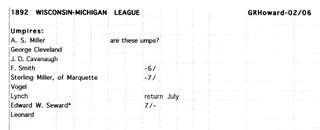
Today and tomorrow I will be posting what Reed Howard has already done on the 1892 Wisconsin-Michigan League.
Today I'm posting standings, league officials and umpires.
Tomorrow I will post a player list that Reed has worked up from his sources. With his limited resources, it's amazing how many players he was able to document.
Tuesday, March 14, 2006
A Follow Up Letter from Kevin McCann
A Follow Up Letter from Kevin McCann
Carlos,
Thanks for sharing your views about stats gathering. Working on the 1935 Kitty League over the past few months has given me a greater appreciation for the work you and other minor league researchers do. It's my first attempt at what really is a tedious but ultimately rewarding project. My opinion is similar to yours. It's better to have a few stats for a season than none at all. That's what I've come to realize with the Kitty League seasons that have none. Maybe I'll only be able to gather 30-40 box scores for a 1903 team, but it's better than having none at all, which is where the record now stands.
My ultimate goal is a book about the Kitty League, but first I feel I need to fill in the statistical gaps in its history, and there's lots of them. I've been working on the league for the past eight years, but I'm just getting into the statisticals part of it now. I've spent a lot of my time in the 1935-1955 period, interviewing living players and researching the newspapers.
When I started out researching, I figured partial records weren't worth much. Now I know better, thanks in large part to your blog and the work other researchers are doing. It would be nice if MLB would grant the Minor League Committee similar funds to correct the ML record as they did for the Negro leagues!
Kevin
I think this is how a lot of minor league researcher start. They want to document the minor league that dominated their region, and consequently produced many memories. Many times they start out— like I did— believing that all the stats must be in the guide for” their league.” How could the guides no include stats for the PCL?I asked myself. It takes only a little delving into the matter to find that baseball statistics evolved— and not always in a straight line.
When I began, I thought I’d just get all the stats from the guides for the Coast League and be done with it. Boy, did I get a surprise! I am nowhere near complete on all I now want to do with the early Coast League. The pitching in the 1920s and part of the 1930s is horrendous, and I would like to redo all the pitching stats for that era. (One thing I noticed is that the league a pitcher a game pitched even if he played another position; i.e., a pitcher is a pitcher is a pitcher, and if he happens to play another position one day they’ll count it as a game played as a pitcher.) But that is a project I’ll be going back to someday. What I am working on now is the complete record of early
Then maybe I’ll get back to the Coast League.
Other people began doing minor league research because of the book Daguerreotypes, which attempted to publish the complete record, major and minor, of the great players. Many researchers, on their own, tried do put together records of the near greats and/or other, but finding that a league that the player appeared in didn’t compile stats (this is especially true for the 19th century), and so would attempt to compile that season. Vern Luse did many league seasons from Sporting Life box scores for that purpose. Bob McConnell does individual players in leagues, compiling only the stats for that season for the player he is working on at that moment.
Monday, March 13, 2006
A 788 Foot Fence
However, the fence stands 788 feet from home plate and not even Babe Ruth of the New York Yankees ever knocked a ball that far. The park is one of magnificent distances, for the left field fence is 315 feet from home plate and that in right field 416 feet.
The Miners utilize the property on Sunday, on which games are forbidden in
Sunday, March 12, 2006
A Letter from Kevin McCann
Kevin is in the process of putting together as complete as possible record for the Kitty League, and had done considerable work so far. The Kentucky-Illinois-Tennessee League was in existence off and on from 1903 through 1955. Kevin is asking a question that every researcher asks at some point in time.
Carlos,
I've asked Ray Nemec this question before, but I'd like your opinion as well. In my Kitty League research, I have four seasons (1903, 1904, 1905, 1922) for which there are no complete, official stats available. For the 1903 season, I already know two newspapers (Henderson and Jackson) no longer exist. I also know some papers did a better job with complete box scores than others; some used only line scores most of the time. My question is this: Knowing these facts, would it still be worthwhile to gather as much data as I can to compile at least a partial season? I figure that a partial season is better than nothing at all. Ray seems to think it would be a waste of time and effort to do so. What's your take?
Thanks,
Kevin
Kevin,Let me tell you a little story. When I first started working my PCL Encyclopedia, one of the big guns of minor league research told me that he had researched 1903 and 1906 and stated flatly that not all the box scores existed, and that it would be a "waste of time" to try to find them.I, of course, found all of them save one box score for 1906, but was even able to make up a pretty good box score from all the game stories. What helped was that the game was played in the Bay Area, and one paper published a box score summary.You say that many of the papers no longer exist. I have been to virtually every library in California that fielded a pro ball club, and out here at least, when a paper goes belly up all its files go to the local library which will then put it on microfilm. I would bet that has happened there in your neck of the woods, too.A lot of minor league baseball research depends on how much effort you want to put into it. Many times, if you go to the town in question, you will find in the microfilm drawer a second or third paper for the period you are doing. (I suspect that to be the case for the 1903, 1904 and 1905 Kitty League. Later years sometimes are not as good.)Many researchers tend to remain at home and try to get things through interlibrary loan, but libraries never send the second or third paper out. If you go to the towns, you may be pleasantly surprised at what you find. People in smaller towns and cities have pride in their local history and tend to preserve more than one would believe.But let's say that Nemec turns out to be right. If you were to go to the towns, and only came up with line scores for the games-- you'd still be able to compile pitcher win-loss records that nobody's ever seen.Last summer, I put 1,500 miles on my car driving around the Central Valley to get box scores for the 1910 & 1911 San Joaquin Valley League. Most of the papers no longer existed in the towns in that league, but they were on microfilm in the local libraries. I didn't get every box score, but I got damn close.Kevin, a lot depends on how much effort you want to put into it. Best wishes, & good researching,Carlos
Saturday, March 11, 2006
A Request for Help From Steve Gietschier
Steve asked me to post this on the blog, and so I here it is. You can get in touch with him at the below email address.
I am looking to borrow a copy of a rather rare book, Dwight Miller's
Sioux Fall Canaries Cross Bats in League Play, 1933-1940. This book was
published in 1941, and it is really hard to find. Book dealer Bobby
Plapinger has none for sale.
If you have a copy and would agree to loan it to me, I will treasure it
as my own, read it, and get it back to you promptly
Please respond directly to me. Thanks.
Best,
Steve Gietschier
sgietsch@sportingnews.com
Steve Gietschier
Senior Managing Editor, Research
Sporting News
10176 Corporate Square Drive
Suite 200
St. Louis, MO 63132
314 993-7787
314 997-0765 FAX
sgietsch@sportingnews.com
Some Websites to Check Out
When I wrote about a couple of minor league websites I look at from time to time, Bill Williamson sent me the following websites that he has found.
Carlos:
Here are some minor league sites I check regularly:
Alabama-Florida League http://www.alabama-florida-league.com/aflintro.htm
Evangeline League http://www.nicholls.edu/baseball/
Nebraska minor league baseball http://marian.creighton.edu/~besser/baseball/second.html
Three I League http://www.three-eye.com/home.htm
And the Blue Ridge site is now back up:
http://www.blueridgeleague.org/
Bill Williamson
Thursday, March 09, 2006
Putting Finis on Final League Averages
With this our final installment of Final League Averages List, we will begin to get back to what passes for normal on this blog. We have received a number of things over the last week, and will present them as we go along.
As anyone can see, the depth of minor league research on leagues well-known and not so well-known. As a researcher once said to me, “Compiling averages for a league is the hardest thing in baseball research…”
It is. First the researcher has to find the league start and stop dates, then collect all the box scores. In the lower leagues, where many researchers toil, you have to get box scores from every town in the league because newspapers only publish their home team’s box score— when at home! Then you have the problem of papers not publishing on Sunday. Then you have the problem of interest. How many times have I seen play-by-play published early in the season become box scores then become line scores before disappearing just before the club goes belly up. Of course, the researcher doesn’t know what he is going to find when he begins. He merely hopes for the best.
With all the box scores in hand— or as many as he will ever find— the researcher begins summing up all the stats while trying to figure out who the players— only identified in the box score by their last name— happen to be. That means reading every game account, every note, in hopes of stumbling upon a first name of a player during eras when it was not common to mention in print a player’s first name.
After all that, the researcher has to make sure everything adds up, balances, and then hopes that somebody will say a kind word about his compilation that had taken him hundreds of hours— at least— of work.
Let’s hear it for those in the list!
Wednesday, March 08, 2006
Tuesday, March 07, 2006
Monday, March 06, 2006
Sunday, March 05, 2006
Former Coast Leaguer Bill Abernathie Dies
David Barker passed this obituary on to me. I will post his complete career record after I finish the current Final League Averages list.
WILLIAM EDWARD ABERNATHIE, SR. January 30, 1929- February 19, 2006 Beloved Daddy, Papa and Friend. Age 77, of Yucaipa, CA. Born in Torrance, CA. Football and Baseball star in the early 40's at Colton HS. He played pro baseball in the 40's & 50's with the San Francisco Seals of the Pacific Coast League and the Cleveland Indians to name a few. He did a 2 year stint with the Marine Corp. and played ball for them as well. He worked for the San Bernardino Sheriff's Dept. for 19 years and retired as a Lt. in 1977. Since that time he has been living life to the fullest with his family and friends! He is survived by one son, William Jr.; daughter-in-law, Carol; and two grandsons, Jake & Wyatt of Yucaipa; one daughter, Pamela Abernathie of Tillamook, Oregon; 3 sisters, Betty of San Diego, Mary Lou and Alice of Oregon. Memorial service will be held on Tuesday, Feb. 28 at 2 p.m. at the United Methodist Church of Yucaipa at 35177 Beech Ave. Reception at the church immediately following. Final resting place will be Montecito Memorial Park in Loma Linda. Flowers may be sent to the church. Published in the San Bernardino Sun from 2/23/2006 - 2/25/2006.



